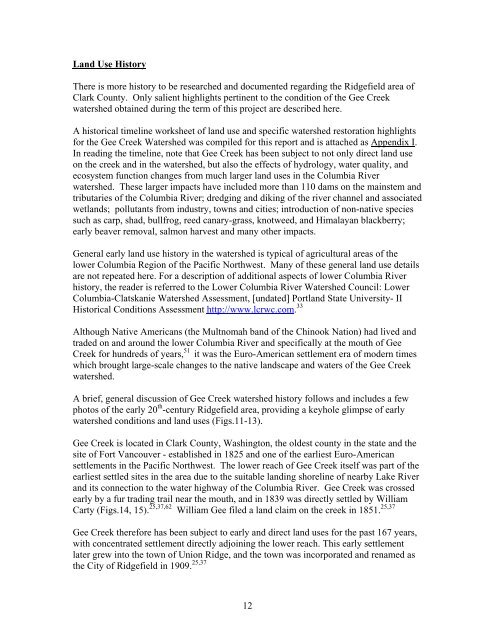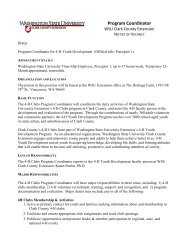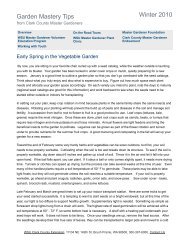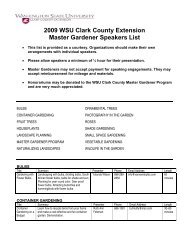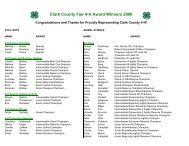gee creek watershed restoration - WSU Clark County Extension ...
gee creek watershed restoration - WSU Clark County Extension ...
gee creek watershed restoration - WSU Clark County Extension ...
You also want an ePaper? Increase the reach of your titles
YUMPU automatically turns print PDFs into web optimized ePapers that Google loves.
Land Use HistoryThere is more history to be researched and documented regarding the Ridgefield area of<strong>Clark</strong> <strong>County</strong>. Only salient highlights pertinent to the condition of the Gee Creek<strong>watershed</strong> obtained during the term of this project are described here.A historical timeline worksheet of land use and specific <strong>watershed</strong> <strong>restoration</strong> highlightsfor the Gee Creek Watershed was compiled for this report and is attached as Appendix I.In reading the timeline, note that Gee Creek has been subject to not only direct land useon the <strong>creek</strong> and in the <strong>watershed</strong>, but also the effects of hydrology, water quality, andecosystem function changes from much larger land uses in the Columbia River<strong>watershed</strong>. These larger impacts have included more than 110 dams on the mainstem andtributaries of the Columbia River; dredging and diking of the river channel and associatedwetlands; pollutants from industry, towns and cities; introduction of non-native speciessuch as carp, shad, bullfrog, reed canary-grass, knotweed, and Himalayan blackberry;early beaver removal, salmon harvest and many other impacts.General early land use history in the <strong>watershed</strong> is typical of agricultural areas of thelower Columbia Region of the Pacific Northwest. Many of these general land use detailsare not repeated here. For a description of additional aspects of lower Columbia Riverhistory, the reader is referred to the Lower Columbia River Watershed Council: LowerColumbia-Clatskanie Watershed Assessment, [undated] Portland State University- IIHistorical Conditions Assessment http://www.lcrwc.com. 33Although Native Americans (the Multnomah band of the Chinook Nation) had lived andtraded on and around the lower Columbia River and specifically at the mouth of GeeCreek for hundreds of years, 51 it was the Euro-American settlement era of modern timeswhich brought large-scale changes to the native landscape and waters of the Gee Creek<strong>watershed</strong>.A brief, general discussion of Gee Creek <strong>watershed</strong> history follows and includes a fewphotos of the early 20 th -century Ridgefield area, providing a keyhole glimpse of early<strong>watershed</strong> conditions and land uses (Figs.11-13).Gee Creek is located in <strong>Clark</strong> <strong>County</strong>, Washington, the oldest county in the state and thesite of Fort Vancouver - established in 1825 and one of the earliest Euro-Americansettlements in the Pacific Northwest. The lower reach of Gee Creek itself was part of theearliest settled sites in the area due to the suitable landing shoreline of nearby Lake Riverand its connection to the water highway of the Columbia River. Gee Creek was crossedearly by a fur trading trail near the mouth, and in 1839 was directly settled by WilliamCarty (Figs.14, 15). 25,37,62 William Gee filed a land claim on the <strong>creek</strong> in 1851. 25,37Gee Creek therefore has been subject to early and direct land uses for the past 167 years,with concentrated settlement directly adjoining the lower reach. This early settlementlater grew into the town of Union Ridge, and the town was incorporated and renamed asthe City of Ridgefield in 1909. 25,3712


